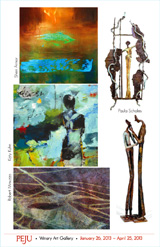Take the tour
 The lost wax process of creating a bronze sculpture is very labor intensive and can take several weeks to complete. To start the process the sculpture must be in wax form. This means that if a sculpture is created using clay, a mold must be made which will be used to create a wax duplicate. Since I work in wax directly it allows me to use very thin pieces and integrate paper, cloth and anything else as long as it is combustible.
The lost wax process of creating a bronze sculpture is very labor intensive and can take several weeks to complete. To start the process the sculpture must be in wax form. This means that if a sculpture is created using clay, a mold must be made which will be used to create a wax duplicate. Since I work in wax directly it allows me to use very thin pieces and integrate paper, cloth and anything else as long as it is combustible.
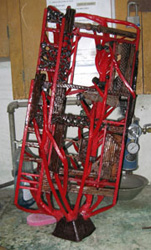
Gating
After the wax sculpture is finished a wax cup and gates (wax sticks) are attached to the sculpture. Gates add strength and will act as channels to guide the bronze to all parts of the sculpture during the pouring process. The cup is the location where the bronze will be poured into the sculpture.
Ceramic Shell Mold
The ceramic shell mold is created using a layering process where the sculpture is dipped into a vat of slurry, coated with ‘sand’, and thoroughly dried before repeating the process. After seven or eight layers the mold is done and the wax must be removed. The bottom of the cup is cleared of excess ceramic shell because it is the location where the wax exits the mold and where the bronze is poured into it.

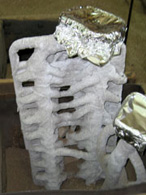
Burnout
The wax is removed by melting in a burnout furnace (lost wax process) that has a hole in the bottom for the wax to drain into a container filled with water to cool it. The cup of the mold must be placed over the hole to ensure that the wax flows out as quickly as possible. During this process the ceramic shell hardens and strengthens.
Bronze Pour
The ceramic shell mold is cleared of excess debris and heated to ready it for the pour. Bronze ingots are melted to over 2000° F in a crucible then poured into the cup of the mold where it courses down through the channels that were created by the ‘lost’ wax. When the cup starts to fill the pour is complete. Within moments the bronze hardens as it starts to cool. For sculptures with very thin parts it is crucial to heat the mold just before pouring otherwise it is likely that those areas will not receive any bronze due to rapid cooling and hardening during the pour.
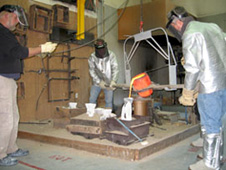

Metal Work and Patina
The sculpture is broken out of the mold with hammers and chisels and then sandblasted. The gates are cut off and texture is restored using grinders, drills, polishers, and any other tools that can be used to add texture. During the cooling process the metal shrinks which can create cracks, tears, and holes that are repaired by welding. If the sculpture is cast in several pieces they are welded together and texture is restored. After the metal work the sculpture is cleaned and a series of patinas are applied. These patinas react chemically with the bronze and range from oxides to acids and may be applied hot or cold depending on the patina. Finally, wax is applied and buffed to bring out the finish.
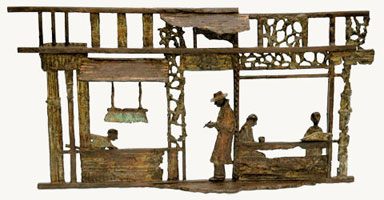
Bronze castings
The castings were done at the West Valley College foundry. David Ogle teaches sculpture and he is leading the process. 'Old Blind John' recorded the videos.
